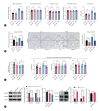GOLM1 promotes cholesterol gallstone formation via ABCG5-mediated cholesterol efflux in metabolic dysfunction-associated steatohepatitis livers
- PMID: 39657752
- PMCID: PMC12016653
- DOI: 10.3350/cmh.2024.0657
GOLM1 promotes cholesterol gallstone formation via ABCG5-mediated cholesterol efflux in metabolic dysfunction-associated steatohepatitis livers
Abstract
Background/aims: Metabolic dysfunction-associated steatohepatitis (MASH) is a significant risk factor for gallstone formation, but mechanisms underlying MASH-related gallstone formation remain unclear. Golgi membrane protein 1 (GOLM1) participates in hepatic cholesterol metabolism and is upregulated in MASH. Here, we aimed to explore the role of GOLM1 in MASH-related gallstone formation.
Methods: The UK Biobank cohort was used for etiological analysis. GOLM1 knockout (GOLM1-/-) and wild-type (WT) mice were fed with a high-fat diet (HFD). Livers were excised for histology and immunohistochemistry analysis. Gallbladders were collected to calculate incidence of cholesterol gallstones (CGSs). Biles were collected for biliary lipid analysis. HepG2 cells were used to explore underlying mechanisms. Human liver samples were used for clinical validation.
Results: MASH patients had a greater risk of cholelithiasis. All HFD-fed mice developed MASH, and the incidence of gallstones was 16.7% and 75.0% in GOLM1-/- and WT mice, respectively. GOLM1-/- decreased biliary cholesterol concentration and output. In vivo and in vitro assays confirmed that GOLM1 facilitated cholesterol efflux through upregulating ATP binding cassette transporter subfamily G member 5 (ABCG5). Mechanistically, GOLM1 translocated into nucleus to promote osteopontin (OPN) transcription, thus stimulating ABCG5-mediated cholesterol efflux. Moreover, GOLM1 was upregulated by interleukin-1β (IL-1β) in a dose-dependent manner. Finally, we confirmed that IL-1β, GOLM1, OPN, and ABCG5 were enhanced in livers of MASH patients with CGSs.
Conclusion: In MASH livers, upregulation of GOLM1 by IL-1β increases ABCG5-mediated cholesterol efflux in an OPN-dependent manner, promoting CGS formation. GOLM1 has the potential to be a molecular hub interconnecting MASH and CGSs.
Keywords: ATP binding cassette transporter subfamily G member 5; Gallstones; Golgi membrane protein 1; Metabolic dysfunction-associated steatohepatitis; Metabolism.
Conflict of interest statement
The authors have no conflicts to disclose.
Figures







References
-
- Lammert F, Gurusamy K, Ko CW, Miquel JF, Méndez-Sánchez N, Portincasa P, et al. Gallstones. Nat Rev Dis Primers. 2016;2:16024. - PubMed
-
- Chen Y, Kong J, Wu S. Cholesterol gallstone disease: focusing on the role of gallbladder. Lab Invest. 2015;95:124–131. - PubMed
-
- Chen Z, Shao W, Li Y, Zhang X, Geng Y, Ma X, et al. Inhibition of PCSK9 prevents and alleviates cholesterol gallstones through PPARα-mediated CYP7A1 activation. Metabolism. 2024;152:155774. - PubMed
MeSH terms
Substances
Grants and funding
LinkOut - more resources
Full Text Sources
Medical
Research Materials
Miscellaneous

